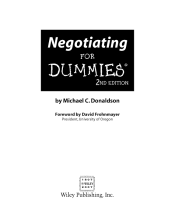Finding and Keeping Superstar Employees
15 important questions on Finding and Keeping Superstar Employees
What is a superstar employee?
- Is capable of taking on increasing responsibilities and contributing to the company's continued growth.
- Is loyal to your vision.
- Shares your ethics and principles.
- Is creative within his or her area of expertise.
- Adds to the synergy of the team by workng effectively with other team members.
- Welcomes positive change.
How does one assemble a top team?
- By running an ad.
- By putting out a siggn or a website posting.
- By encouraging referrals from employees, vendors, and customers.
Never accept an applicant for a responsible position without first obtaining a professionally prepared resume. The tough part comes after you've collected the resumes: you must interview, then reinterview, and then reinterview again. You must check those often-camouflaged references, whose primary function, you soon discover, is to tell you as little as possible about a candidate's faults in between glowing adjectives aimed at his strengths.
Which open-ended questions can help you discover those superstar job applicants?
- What's the number on trait that differentiates you from other applicants?
- What's your most significant business achievement?
- What was your biggest failure and what did you learn from it.
- What are your weaknesses?
- What are your strengths?
- Who's the best boss you've ever worked for and what made him or her so good?
- Who was the worst boss you've ever worked for and what made him or her so bad?
- What do you want to be doing five years from now.
- Higher grades + faster learning
- Never study anything twice
- 100% sure, 100% understanding
What are the major training options?
- Consultants and Coaches
- Vendors
- Seminars
- Schooling
- Books
- Internet
By what is the typical employee motivated?
- Recognition or appreciation
- Interesting work
- Wages
- Awareness of what's going on in the company
- Good working conditions
- Job security
- Feeling that management cares about the employee
By what is the typical entrepreneur motivated?
- Creativity or Growth
- Money
- Power
- Freedom
- Survival
How can you compensate employees?
- Hourly: works especially for your part-time and entry-level employees.
- Salaried: as a rule, salaries represent security to their recipients, and security is number six on the employee motivation list.
- Commission: always the best compensation method for the hungry, hard-charging, sales types.
- Pay-for-performance: usually involves a relatively small base salary with all other compensation based on either individual or team performance (or a combination of both.
- Hybrids: a mix of annual salary, pay-for-performance, annual bonuses, stock-option plans, and whatever else you can devise.
How do you set goals that work (SMART)?
SMART:
- S = Specific
- M = Measureable and Meaningful
- A = Appropriate
- R = Realistic
- T = Time limit
- Never set goals without first planning how to reach them.
- Don't wait until the end of the goal-setting period to do the measuring.
- Allow for the unexpected.
- Make a public anouncement within the business as soon as your business or your employees have achieved goals.
- Understand that an employee may occasionally come up short on his goals.
How do you write performance expectations?
- Include a brief explanation of what the position's objective (or mission) is and how the position relates to the business's overall mission.
- Describe the position's location on the organization chart.
- Define the performance evaluation process.
- Concentrate on output, not activity, and be careful not to limit the ways in which the job can be accomplished.
- Be flexible.
What does an evaluation process include?
- Writing performance expectations.
- Setting goals.
- Creating critical-event memos.
- Prividing interim feedback.
- Conducting the annual performance and salary review.
- Scheduling the follow-up reviews.
Which questions should be included in an exit interview?
- What was the main factor in your decision to quit?
- What did you like the most about our company?
- What did you like the least?
- How do you rate such issues as working conditions, cooperation and teamwork, on-the-job training, supervision, opportunity for promotion, and communication?
- If you could change one thing about this company, what would it be?
How do go through the unpleasant task of firing an employee?
- Explore all the alternatives before settling on dismissal.
- Do the firing as soon as possible after you make the decision to terminate.
- Know the laws of your state.
- Prepare the firing package in the same organized and documented manner in which you prepared the hiring package.
- Plan the firing meeting as you would any other important business meeting.
- Perform the termination first thing in the morning.
- Don't argue.
- Arrange for outplacement services. You can soften the firing by helping the employee get back on his feet again.
How do you construct your business's organization chart and use it effectively?
- Construct the organization chart based on the employees, not the "organization".
- Pay by the quality of each employee's performance and his contribution to the team, not his position on the organization chart.
- Determine how many employees one person can supervise.
Flatter organization charts are better, especially when you have the right employees. Flatter organization charts mean better communication - from top to bottom and bottom to top - because the communication doesn't have to pass through intermediaries.
What can a well-prepared employee manual do for you?
- The employee manual provides the first opportunity to define your corporate missions and goals to your new employees and sets the tone for what's to come.
- The employee manual saves time - time spent on resolving problems that established policies in a manual would've prevented in the first place.
- The employee manual saves time, effort, and money spent on lawyers by establishing company policies for all to see.
What are reasons for the fact that an employee didn't perform a task?
- The employee is incapable of performing the task.
- The employee isn't properly trained.
- The task and its priority weren't clearly communicated.
- The employee saw no good reason to accomplish the task and, thus, elected not to do it.
The question on the page originate from the summary of the following study material:
- A unique study and practice tool
- Never study anything twice again
- Get the grades you hope for
- 100% sure, 100% understanding
































